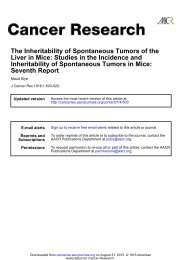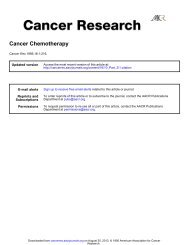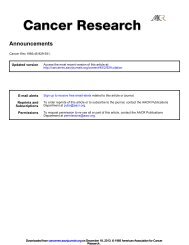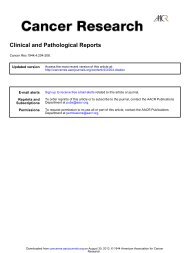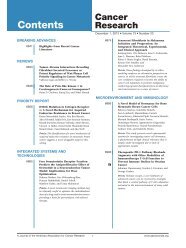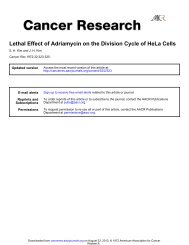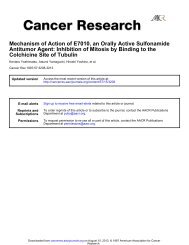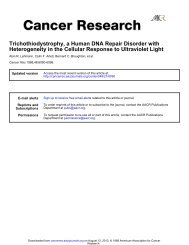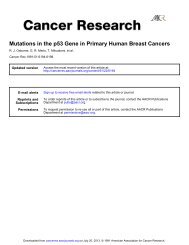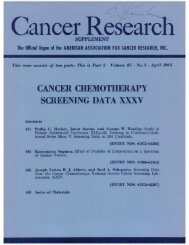Isolation and Characterization of a Hepatoma ... - Cancer Research
Isolation and Characterization of a Hepatoma ... - Cancer Research
Isolation and Characterization of a Hepatoma ... - Cancer Research
You also want an ePaper? Increase the reach of your titles
YUMPU automatically turns print PDFs into web optimized ePapers that Google loves.
[CANCER RESEARCH 49, 6493-6497, December I, 1989]<br />
<strong>Isolation</strong> <strong>and</strong> <strong>Characterization</strong> <strong>of</strong> a <strong>Hepatoma</strong>-associated Abnormal (Des-7carboxy)prothrombin1<br />
Howard A. Liebman<br />
William B. Cosile llematology <strong>Research</strong> Laboratory, Division <strong>of</strong> Hematology-Oncology, Boston City Hospital, <strong>and</strong> Boston University School <strong>of</strong> Medicine,<br />
Boston, Massachusetts 02118<br />
ABSTRACT<br />
<strong>Hepatoma</strong>-associated abnormal (des-7-carboxy)prothrombin (HAPT)<br />
is a newly described tumor marker for hepatocellular carcinoma. 11Al' I<br />
has been measured in the blood <strong>of</strong> patients with hepatoma by immunoassay<br />
but has not been isolated or characterized. This paper describes the<br />
quantitative isolation <strong>and</strong> structural characterization <strong>of</strong> HAPT. Purified<br />
HAPT has the same molecular weight, amino-terminal sequence, <strong>and</strong><br />
amino acid analysis (exclusive <strong>of</strong> 7-carboxyglutamic acid) as native<br />
prothrombin <strong>and</strong> abnormal prothrombin isolated from the blood <strong>of</strong> pa<br />
tients taking sodium warfarin. 11API' is heterogeneous in 7-carboxyglu<br />
tamic acid (Gla) content with an average <strong>of</strong> 5 Gla residues/molecule<br />
compared to 10 Cla residues for native prothrombin <strong>and</strong> 2 Gla residues<br />
for abnormal prothrombin. HUM is glycosylated in a manner equivalent<br />
to that for native prothrombin when evaluated by a concanavalin Abinding<br />
assay. These studies find structural identity between 11\ P'l <strong>and</strong><br />
abnormal prothrombin. Therefore the findings support the hypothesis<br />
that HAPT results from an acquired defect in the posttranslational<br />
vitamin K-dependent carboxylation <strong>of</strong> the prothrombin precursor <strong>and</strong> not<br />
an intrinsic defect in the prothrombin precursor molecule.<br />
INTRODUCTION<br />
Prothrombin is the major vitamin K-dependent blood coag<br />
ulation protein synthesized by the liver (1). In the presence <strong>of</strong><br />
sufficient quantities <strong>of</strong> vitamin K, 10 NH2-terminal glutamic<br />
acid residues undergo a posttranslational 7-carboxylation (2-<br />
4). The resulting Gla2 residues confer metal-binding properties<br />
essential for functional activity (5). In the absence <strong>of</strong> vitamin K<br />
or in the presence <strong>of</strong> vitamin K antagonists, the vitamin Kdependent<br />
carboxylase activity in the liver is inhibited <strong>and</strong> des•y-carboxyforms<br />
<strong>of</strong> prothrombin (abnormal prothrombin) are<br />
released into the blood (6, 7). The abnormal prothrombin<br />
cannot bind metal ions <strong>and</strong> is devoid <strong>of</strong> functional activity.<br />
Conformation-specific antibodies against these abnormal forms<br />
<strong>of</strong> prothrombin have been developed <strong>and</strong> can be used to quantitate<br />
the levels <strong>of</strong> abnormal prothrombin antigen in blood (8,<br />
9).<br />
We have reported that abnormal prothrombin antigen is<br />
increased in the blood <strong>of</strong> patients with hepatocellular carcinoma<br />
(10). Abnormal prothrombin antigen in these patients is not<br />
due to vitamin K deficiency since it did not disappear with<br />
parenteral vitamin K. The abnormal prothrombin antigen was<br />
eliminated or reduced with tumor resection or with chemother<br />
apy supporting the primary role <strong>of</strong> the hepatoma in the synthe<br />
sis <strong>of</strong> this antigen. These findings suggest that abnormal pro<br />
thrombin antigen may be a useful new serum marker <strong>of</strong> primary<br />
hepatocellular carcinoma. Subsequently, other investigators<br />
have confirmed these findings using different assay systems<br />
(11-13).<br />
Received 5/2/89; revised 8/28/89: accepted 9/6/89.<br />
The costs <strong>of</strong> publication <strong>of</strong> this article were defrayed in part by the payment<br />
<strong>of</strong> page charges. This article must therefore be hereby marked adverlisenn'nìin<br />
accordance with 18 U.S.C. Section 17.14solely to indicate this fact.<br />
1This work was supported by grants from the American <strong>Cancer</strong> Society (PDT-<br />
256) <strong>and</strong> the NIH (I R29 HL .Ì9C65).<br />
J The abbreviations used are: Gla. vcarboxyglutamicacid; NPT. human name<br />
prothrombin; APT. abnormal prothrombin; TBS. 0.05 M Tris-0.15 M NaCI. pH<br />
7.4; HAPT. hepatoma-associated abnormal (des-vcarboxy) prothrombin: HPLC.<br />
high performance liquid Chromatograph)-.<br />
6493<br />
While the abnormal prothrombin antigen in these patients is<br />
assumed to be similar to abnormal prothrombin in the plasma<br />
<strong>of</strong> patients treated with warfarin, the hepatoma-associated ab<br />
normal prothrombin antigen has not been purified from the<br />
blood <strong>of</strong> patients with hepatoma to demonstrate a structural<br />
relationship. I have now quantitatively isolated <strong>and</strong> character<br />
ized a hepatoma-associated abnormal prothrombin from the<br />
malignant ascites <strong>of</strong> a patient. Analysis <strong>of</strong> this protein demon<br />
strates structural identity with the partially carboxylated non<br />
functional prothrombin species isolated from the blood <strong>of</strong> pa<br />
tients taking sodium warfarin. These studies further support<br />
the hypothesis that abnormal prothrombin in the blood <strong>of</strong><br />
patients with hepatocellular carcinoma is secondary to a defect<br />
in the vitamin K-dependent carboxylation system in the pa<br />
tient's tumor.<br />
MATERIALS AND METHODS<br />
Protein Preparation. NPT was purified by barium citrate absorption,<br />
DEAE-Sephacel chromatography, <strong>and</strong> dcxtran sulfate chromatography<br />
using st<strong>and</strong>ard methods (14. 15). In later experiments, human native<br />
prothrombin was isolated directly from plasma on a column <strong>of</strong> antiprothrombin:Ca(Il)<br />
antibodies by modification <strong>of</strong> methods published<br />
previously (16, 17). APT was prepared by the method <strong>of</strong> Blanchard et<br />
al. (9).<br />
HAPT was purified from patient ascites fluid by ion-exchange chro<br />
matography <strong>and</strong> immunoaffinity chromatography (17). Approximately<br />
500 ml <strong>of</strong> ascites fluid collected in 3 mM EDTA was made 1 m.M<br />
diisopropylphosph<strong>of</strong>luoride <strong>and</strong> 1 mM benzamidine. The ascites fluid<br />
was then dialyzed at 4°Covernight against 0.1 M potassium phosphate,<br />
pH 7.5, containing 1 mM benzamidine. Prothrombin species were<br />
purified by ion-exchange chromatography using a DEAE-Sephacel A-<br />
50 column (3x8 cm) equilibrated with 0.1 M potassium phosphate,<br />
pH 7.5. containing 1 mM benzamidine. Dialyzed ascites fluid, after<br />
centrifugation. was applied to the column, <strong>and</strong> the column was washed<br />
exhaustively with the equilibration buffer. Bound protein was eluted<br />
with 0.5 M potassium phosphate. pH 7.5, containing 1 mM benzami<br />
dine. The eluate was pooled, made 1 mM in diisopropylphosph<strong>of</strong>luoride.<br />
<strong>and</strong> dialyzed at 4°Covernight against 0.1 M boric acid-1 M NaCI-1 mM<br />
benzamidine-0.1% Tween 20, pH 8.5.<br />
The prothrombin species were purified by immunoafTinity chroma<br />
tography. The eluate from the DEAE column was applied to an antiprothrombin<br />
antibody-Sepharose column (1x5 cm) <strong>and</strong> the column<br />
was washed with 0.1 M boric acid-1 M NaCl-1 mM benzamidine-0.1%<br />
Tween 20. pH 8.5. Bound prothrombin was eluted with 4 M guanidine-<br />
HC1 <strong>and</strong> then immediately pooled <strong>and</strong> dialyzed at 4°Cagainst 0.05 M<br />
Tris-0.5 M NaCI-1 HIMbenzamidine-HCl-0.01% Tween 20, pH 7.5. An<br />
anti-prothrombin:Ca(II) antibody-Sepharose affinity column was then<br />
used to remove contaminating fully carboxylated native prothrombin<br />
(16, 17). After dialysis, the prothrombin species were made 5 mM<br />
CaC12 <strong>and</strong> applied to the anti-prothrombin:Ca(II) antibody-Sepharose<br />
column equilibrated with TBS-5 mM CaCI2. The HAPT did not bind<br />
to the column <strong>and</strong> was collected in the flow-through. The small quan<br />
tities <strong>of</strong> contaminating native prothrombin were eluted from the column<br />
with 10 mM EDTA.<br />
Immunoassays <strong>and</strong> Coagulation Assays. Total prothrombin antigen,<br />
fully carboxylated native prothrombin antigen, <strong>and</strong> abnormal pro<br />
thrombin antigen were measured by radioimmunoassays as described<br />
previously (8, 9). The calcium-dependent prothrombin coagulant activ-<br />
Downloaded from<br />
cancerres.aacrjournals.org on July 30, 2013. © 1989 American Association for <strong>Cancer</strong> <strong>Research</strong>.




